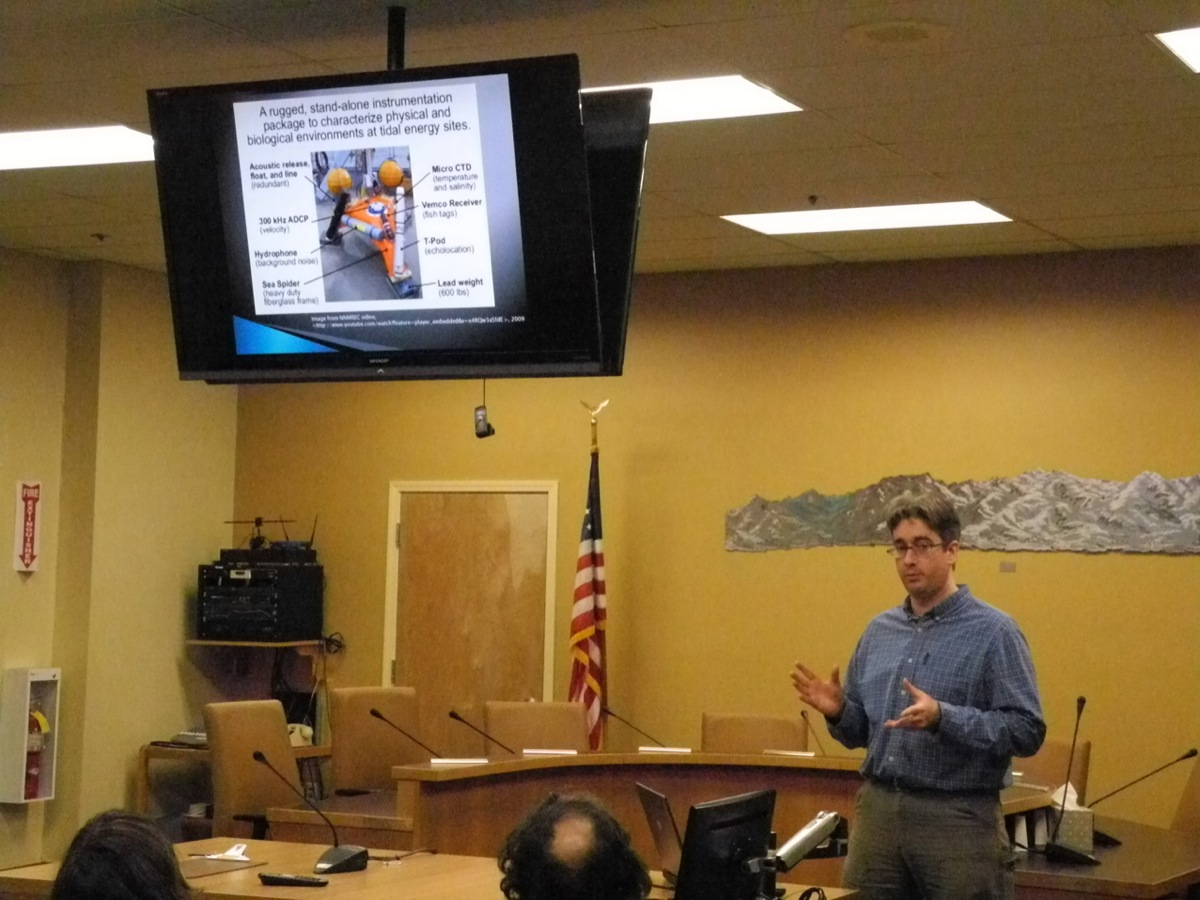An idea to use the Homer Deep Water Dock as a test bed to measure and evaluate tidal energy got a boost with a city-university collaboration. Instead of the city hiring a private firm, a group of seven University of Alaska Anchorage engineering students and their professors are doing the 35-percent design for the Tidal Energy Incubator Project.
The cost?
“We’ve been able to take advantage of some free labor by feeding them cookies to get to that first 35 percent,” said Katie Koester, city of Homer economic development coordinator, joking.
Well, cookies and expenses like travel to bring the students and two professors to Homer. The Homer City Council appropriated $2,500 for travel. The students, all seniors in the engineering program, are doing the work as part of their student Capstone Engineering Project, part of the requirements for a degree.
On Feb. 19, the seven students and their engineering professor, Dr. Orson Smith, visited Homer, toured the Deep Water Dock and did a presentation at Homer City Hall about their project. The group includes two students from Homer, Dan Boone and Sava White. Also on the team are Ian Dorman, Michael Hamman, Matt Madsen, Weiran Man and Drew Nielson.
With Homer’s extreme tides and a road-accessible harbor that’s also connected to the southcentral Alaska power grid, putting equipment at or near the Deep Water Dock will allow tidal energy system developers to gather information and test equipment in harsh marine environments with ice, sediments and subzero temperatures. Tidal energy systems use the energy of changing tides and currents to power turbines — sort of like the Bradley Lake hydroelectric plant, except tides power turbines instead of falling water.
“The idea is, this is an incubator,” said Jim Levine, a Homer Electric Association board member and a booster of renewable energy. “We’re looking for researchers who have an idea and want to have someplace to try out their idea and physically test it on a small scale.”
Rep. Paul Seaton, R-Homer, was an early promoter of the Tidal Energy Incubator Project. A loose working group has formed to meet and discuss the plan, including representatives from the National Oceanic and Atmospheric Administration, Homer Electric Association, the U.S. Department of Energy, the Homer Harbor and Homer Public Works, UAA and the Kachemak Bay Research Reserve.
At the urging of Mayor Beth Wythe, the city council also appropriated $100,000 as a reimbursable grant to another group to develop the incubator project. The city had put the project in its capital improvement project list seeking funding from the state, but decided to fund it on its own.
The UAA students formed subgroups to look at engineering issues like the tidal energy incubator structure, instrumentation needs and power connections. For example, student Michael Hamman said one challenge in the design is coming up with a cradle for instruments and turbines.
“We have to have a system of lowering and lifting the hydroturbines, the hydroconnect systems going up and down as the tide fluctuates,” he said.
The test cradle could be attached to the dock or it could be on a floating barge. The hydroturbine has to be close enough to the water to maximize tidal currents.
As for instruments, a big measurement is of water velocity, but other data needed to be collected are sediment and salinity. Even the sound generated by the turbines is important for its impact on whales, dolphins and other marine life.
With access to the local HEA power grid, the tidal incubator also could support a working power turbine that would put energy into the grid.
“Not only can you test your equipment here, you can test if your power can be delivered to a utility,” said engineering student Ian Dorman.
He noted one drawback: under HEA’s net metering rules, which allow consumers to put power back into the grid in return for energy credits, a maximum of 25 kilowatts can go back in. If a test turbine generated more, new rules would have to be written. Levine said 25 kw would probably be big enough for a test project.
A small, local tidal energy project might be one benefit of the incubator, said Kris Holderied, director of the NOAA-University of Alaska Fairbanks Kasitsna Bay Laboratory.
“We’re not ruling out the possibility that people come up with designs for production off docks in small communities,” Holderied said. “We could power the Ice Plant.”
“That would be huge,” Koester said.
“That would be really huge,” said Homer Harbormaster Bryan Hawkins.
The UAA design team will have a draft report by April 17 and present a final report to the city by April 26.
Michael Armstrong can be reached at michael.armstrong@homernews.com.
UAA students work on Tidal Energy Incubator


